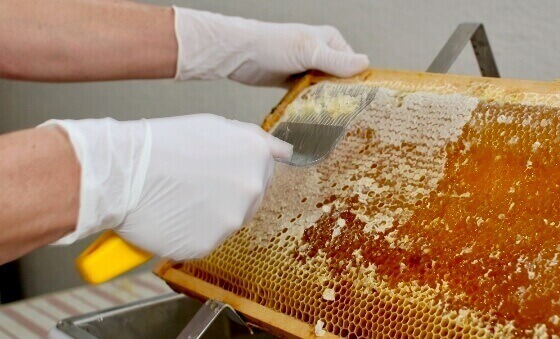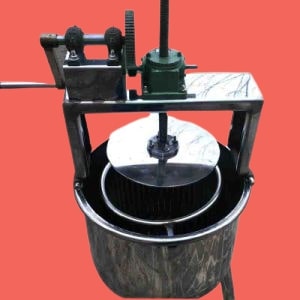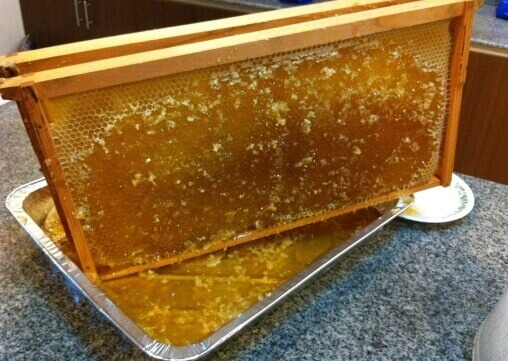Ever wondered where the honey stored in the jar stocked in your kitchen shelf comes from? How exactly do beekeepers extract honey? The process of obtaining decadent golden honey has always intrigued me.
Read this article till the end to understand this process of extraction and carry it out yourself.
Honey bees are the only bees that produce honey, hence the name. This is because honey bees stay active throughout the year. The actual process of production occurs between spring and autumn. Depending on the climate, you can choose when you want to extract the honey. Most beekeepers repeat the process several times in a year.
Pick a warm climate which is conducive to honey production. During wet or rainy seasons, the bees themselves have a tough time gathering enough resources to produce honey. So, even if it’s the summer weather, consider the climate.
Extracting honey from a honeycomb with an extractor

It’s a 5-step process.
- Uncap the honeycomb.
- Spin the honey out.
- Filter the honey.
- Let it settle for a couple of days.
- After this, store it in a jar and your viola, your honey is ready for consumption.
The honeycomb is made up of individual cells which store honey and have a layer of beeswax on top of it. You have to get rid of the beeswax to obtain the honey. Your honeycomb should be inside a frame to facilitate the process.
Usually, a hot knife is used to facilitate the removal of honey, however, I’ve talked to experts who like to use an uncapping comb. This retains the beeswax structure located underneath and gets rid of only the top layer. You can put aside the capping and use it for varied purposes.
After the cappings are removed, apply pressure to get honey from the comb. Beekeepers usually use extractors. Extractor can be electric or hand powered. Put the honeycombs which are in the frame inside the extractor. Depending on your extractor, place the appropriate amount of frames.
The extractors will spin the frames around to extract honey. The honey will separate from the honeycomb and accumulate at the bottom of the drum. There should be a tap at the base of the extractor so that you can collect the honey.
The beeswax structure should still be intact and remnants of beeswax will be retained in the honeycomb. Filter out the beeswax first, the remaining beeswax can be used to make lip balms or candles.
Allow your honey to collect for at least two days. This lets the remaining beeswax form a layer at the top of the collected honey. You can easily remove it with a spoon or a honey tank. A honey tank will let the honey settle within the tank. There should be a tap at the bottom that lets you fill out honey jars.
If you’re not using a honey tank, use sterilized ladles to store the honey in jars. Make sure to also use sterilized containers. This ensures that your honey has an indefinite shelf life.
Pour your all-natural honey on toast, waffles, pancakes or simply put a spoonful in your mouth and enjoy.
Extracting honey from a honeycomb without an extractor
Getting an extractor is an expensive investment. Even if you buy an extractor, storage is a glaring problem. I do not recommend buying an extractor, if you’re not planning on selling honey.
One or two dozens of honeycomb frames do not require an extractor. Especially if you are extracting only for domestic purposes. I say, put that purchase on hold.
The cut comb process
Literally, all you need is a sharp knife, a cooling rack or a queen excluder, and a tray. If you’re a baker, you must already have these products. A baking sheet is recommended but not necessary.
- Put the cooling tray on top of the tray or the baking sheet and place the honeycomb frame on top.
- Slice the comb into 4-inch squares with your knife. Ensure to sterilise the knife after each cut.
- Separate the pieces and let it drain for several hours.
- Put the pieces on a flat utensil and cover it tightly with food wrap.
- You can then collect the drained honey.
Scrape the frames of wax
- Take the frames of honeycomb and scrape the honey out with a fork.
- Strain the honey through a strainer into a bowl. You can suspend the strainer from a high point so that the honey can naturally collect into the bowl.
- Store the collected honey in jars.
This method works best, if you have only 3-4 honeycomb frames.
Honey press
The honey press is a mechanical device that has been specially designed to extract honey from the honeycomb. The honeycomb is pressed against two metal surfaces crushing the comb into wax. There are two types of honey presses – roller and pressure plate. I personally recommend using a pressure plate honey press.
- Cut the honeycomb into small pieces. Place the cut pieces of beeswax in the honey press.
- Press down the T-shaped handle.
- Tighten the screw at the pressure plate and align the handle with the screw.
- Rotate the handle in a clockwise motion.
- Honey should flow out of the press.
- Collect the honey and store it into containers.
For this process to work, the honeycomb should be at 80’ F or warmer. If the temperature of the comb falls below 70’, you should continue the process for a few days. Otherwise, the process can be completed in one day. Make sure to not overheat the honeycomb or else, you risk losing nutritional value.
This method is labor intensive, hence, I do not recommend it if you have several frames. It also destroys the honeycomb so the bees cannot build it back up again.

Drip method
- Arrange a long aluminium trough or use several aluminium trays.
- Uncap the beehive frames with an uncapping knife.
- Place the honeycomb frame against the side of the tray in a way that the uncapped frame faces downwards. Let the honey drip into the aluminium tray for at least 24 hours.
- Once this process is completed, place the honeycomb frame back in the beehive.
- Strain the honey from the aluminium tray into a collecting bucket.
This process ensures that you extract the maximum amount of honey. However, you can’t make use of beeswax.

8 tips for harvesting honey
- Be patient. If you’re a newbie, you should know that extraction of honey is a slow process. You’ll learn in time. It can take upto several days and you might waste some honey, the first time.
- Extracting honey is a draining process. Hence, extract honey on one day and bottle it up the next day. Ask for help from friends and family.
- You should harvest honey in an enclosed, well-ventilated area.
- Make sure the weather is warm or carry out the process in a warm space. This will make your honey flow easily.
- Look for substitutes. Make do with the things you already have, learn the process and then invest in expensive machinery.
- Keep the honey covered. Uncovered honey will absorb moisture and attract insects.
- A bowl of water and a towel is a lifesaver in the process of extraction. This will prevent your fingers from getting sticky.
- Consider using a method that does not crush the honeycomb so that you can place the honeycomb back in the beehive.
There are many perks of extracting your own honey. You can make sure that no bees were harmed in the process. The honey you obtain is fresh and completely natural. If the method is carried out properly, your honey can literally last forever. And the fruits of your labor are always sweeter.
Read here more: